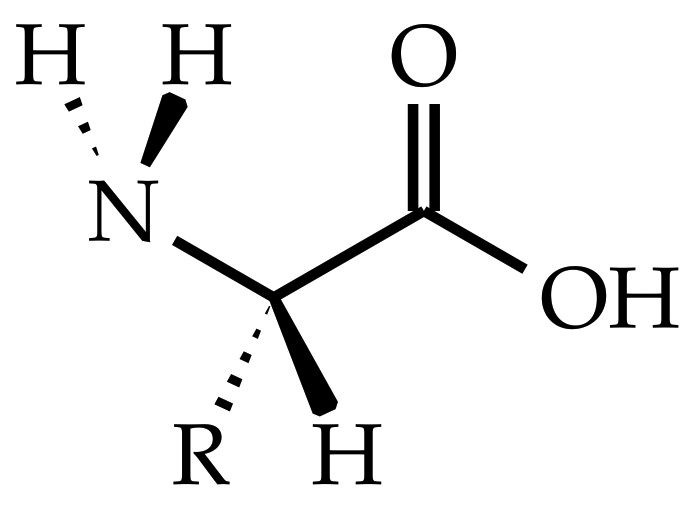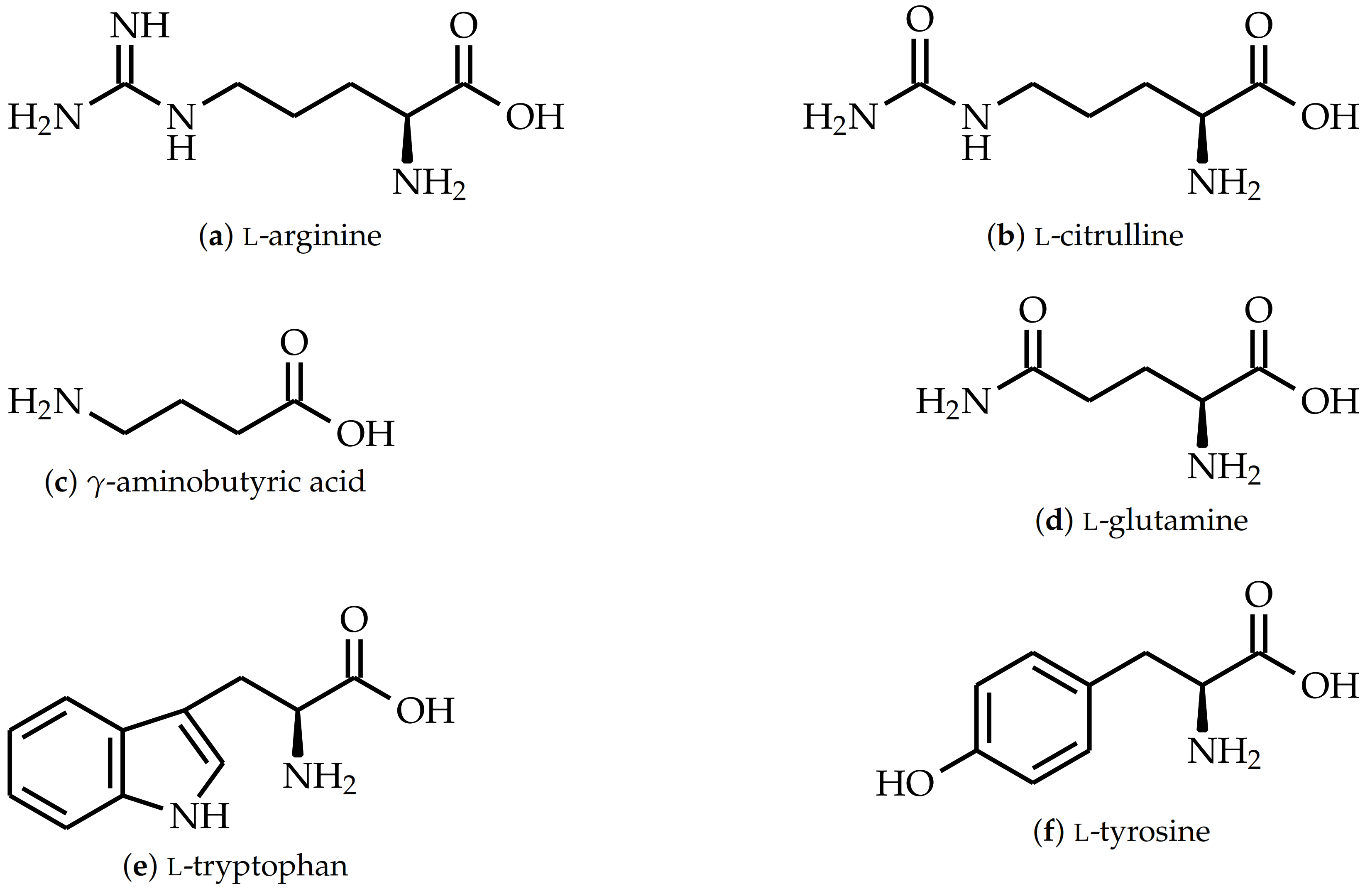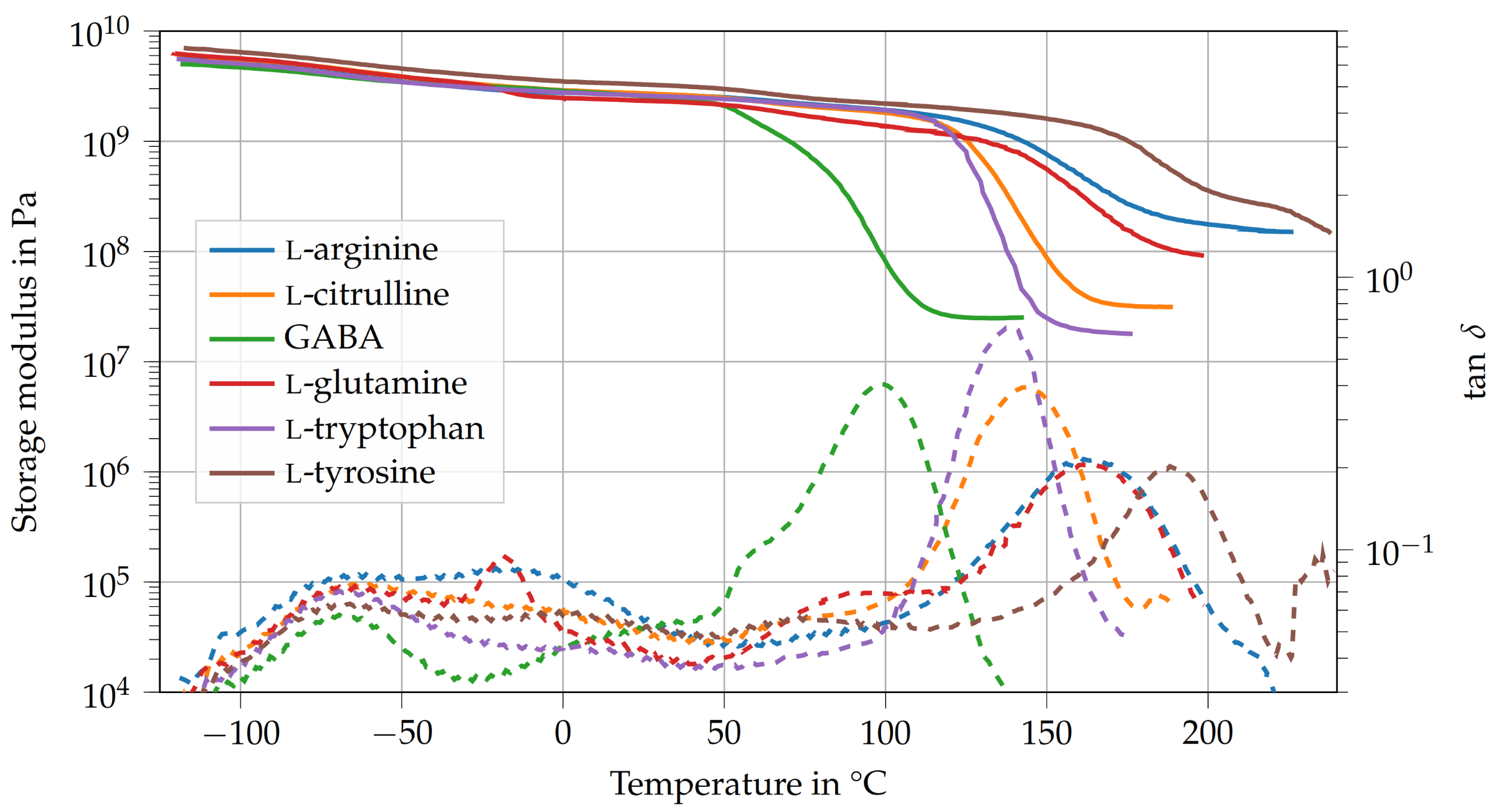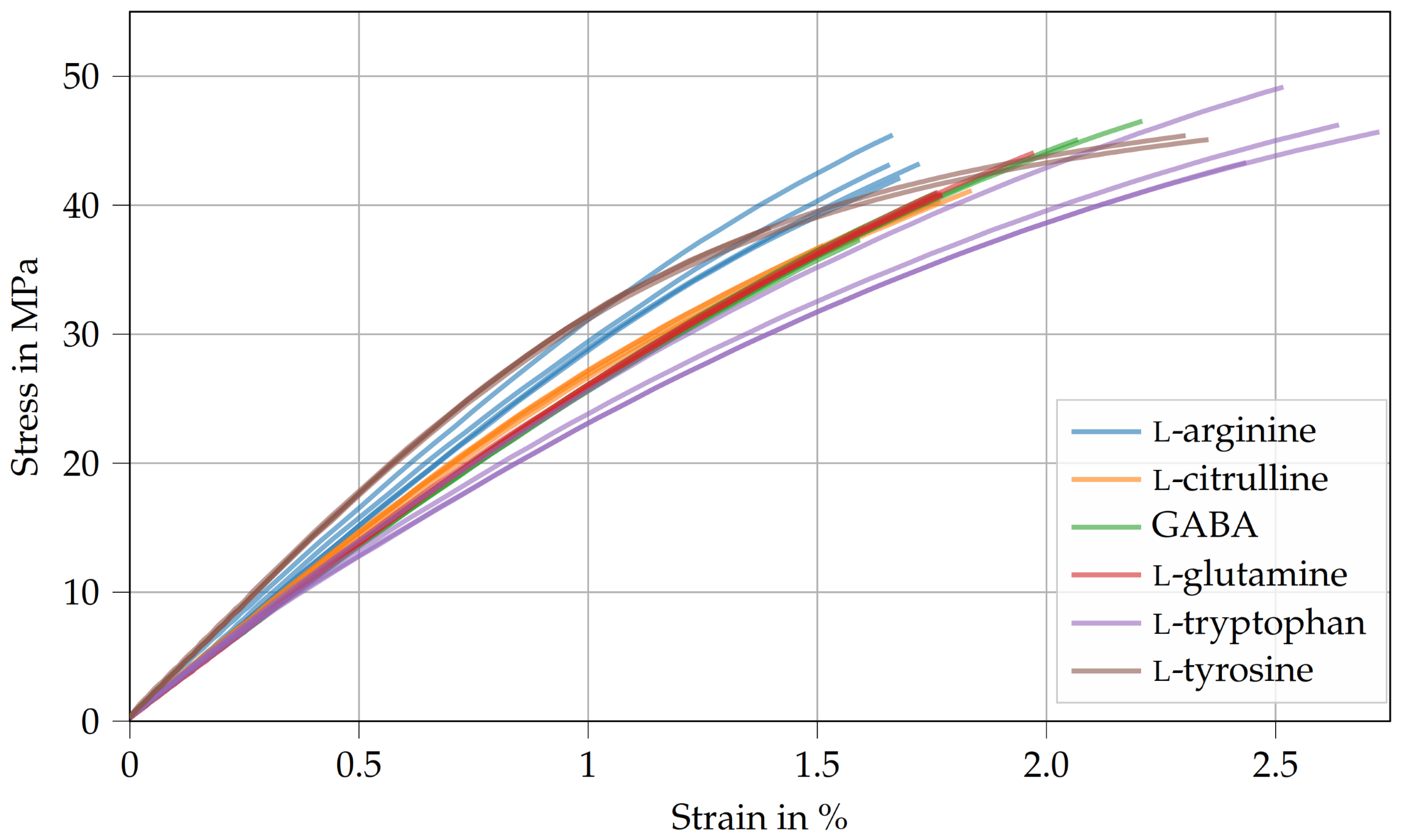Amino Acids as Bio-Based Curing Agents for Epoxy Resin: Correlation of Network Structure and Mechanical Properties
Abstract
1. Introduction
2. Materials and Methods
2.1. Materials
2.2. Resin Formulation
2.3. Curing Cycle and Sample Preparation
2.4. Characterization Methods
2.4.1. Dynamic Mechanical Analysis
2.4.2. Tensile and Compression Tests
2.4.3. Three-Point Bending
2.4.4. Fracture Toughness
3. Results and Discussion
3.1. Dynamic Mechanical Analysis
3.2. Tensile Tests
3.3. Three-Point Bending
3.4. Compression Tests
3.5. Fracture Toughness
3.6. Correlations between Material Properties
4. Conclusions
Author Contributions
Funding
Acknowledgments
Conflicts of Interest
References
- Schürmann, H. Konstruieren mit Faser-Kunststoff-Verbunden; Springer: Berlin, Germany, 2007. [Google Scholar]
- Lengsfeld, H.; Wolff-Fabris, F.; Krämer, J.; Lacalle, J.; Altstädt, V. Faserverbundwerkstoffe—Prepregs und ihre Verarbeitung; Hanser Publishers: Munich, Germany, 2014. [Google Scholar] [CrossRef]
- Bourne, L.; Milner, F.; Alberman, K. Health problems of epoxy resins and amine–curing agents. Am. J. Ind. Med. 1959, 16, 81–97. [Google Scholar] [CrossRef] [PubMed]
- Greim, H.; Bury, D.; Klimisch, H.J.; Oeben-Negele, M.; Ziegler-Skylakakis, K. Toxicity of aliphatic amines: Structure-activity relationship. Chemosphere 1998, 36, 271–295. [Google Scholar] [CrossRef] [PubMed]
- Venables, K. Low molecular weight chemicals, hypersensitivity, and direct toxicity: The acid anhydrides. Occup. Environ. Med. 1989, 46, 222–232. [Google Scholar] [CrossRef] [PubMed]
- Anku, W.; Mamo, M.; Govender, P. Phenolic Compounds in Water: Sources, Reactivity, Toxicity and Treatment Methods; IntechOpen: London, UK, 2017. [Google Scholar] [CrossRef]
- Leuchtenberger, W.; Huthmacher, K.; Drauz, K. Biotechnological production of amino acids and derivatives: Current status and prospects. Appl. Microbiol. Biotechnol. 2005, 69, 1–8. [Google Scholar] [CrossRef] [PubMed]
- Nelson, D.; Cox, M. Lehninger Principles of Biochemistry; MacMillan Learning: New York City, NY, USA, 2021. [Google Scholar]
- Larsen, P. 6—Physical and Chemical Properties of Amino Acids; Academic Press: London, UK, 1980. [Google Scholar] [CrossRef]
- Li, Y.; Xiao, F.; Wong, C. Novel, Environmentally Friendly Crosslinking System of an Epoxy Using an Amino Acid: Tryptophan-Cured Diglycidyl Ether of Bisphenol A Epoxy. J. Polym. Sci. Part A Polym. Chem. 2007, 45, 181–190. [Google Scholar] [CrossRef]
- Motahari, A.; Omrani, A.; Rostami, A. Theoretical study on the mechanism of epoxy cured with tryptophan in the presence of 2,4,5-triphenylimidazole as a catalyst. Comput. Theor. Chem. 2011, 977, 168–180. [Google Scholar] [CrossRef]
- Gnanasekar, P.; Yan, N. Synthesis and thermo-mechanical properties of novel spirobiindane based epoxy nanocomposites with tryptophan as a green hardener: Curing kinetics using model free approach. Polym. Degrad. Stab. 2019, 163, 110–121. [Google Scholar] [CrossRef]
- Motahari, A.; Rostami, A.; Omrani, A.; Ehsani, M. On the Thermal Degradation of a Novel Epoxy-Based Nanocomposite Cured With Tryptophan as an Environment-Friendly Curing Agent. J. Macromol. Sci. Part B Phys. 2015, 54, 517–532. [Google Scholar] [CrossRef]
- Mazzocchetti, L.; Merighi, S.; Benelli, T.; Giorgini, L. Evaluation of Tryptophan—Late curing agent systems as hardener for epoxy resin. AIP Conf. Proc. 2018, 1981, 020170. [Google Scholar] [CrossRef]
- Merighi, S.; Mazzocchetti, L.; Benelli, T.; Giorgini, L. Evaluation of Novel Bio-Based Amino Curing Agent Systems for Epoxy Resins: Effect of Tryptophan and Guanine. Processes 2021, 9, 42. [Google Scholar] [CrossRef]
- Rothenhäusler, F.; Ruckdaeschel, H. L-Arginine as a Bio-based Curing Agent for Epoxy Resins: Glass Transition Temperature, Rheology and Latency. Polymers 2022, 14, 4331. [Google Scholar] [CrossRef]
- Shibata, M.; Fujigasaki, J.; Enjoji, M.; Shibita, A.; Teramoto, N.; Ifuku, S. Amino acid-cured bio-based epoxy resins and their biocomposites with chitin- and chitosan-nanofibers. Eur. Polym. J. 2018, 98, 216–225. [Google Scholar] [CrossRef]
- Rothenhäusler, F.; Ruckdaeschel, H. l-Arginine as Bio-Based Curing Agent for Epoxy Resins: Temperature-Dependence of Mechanical Properties. Polymers 2022, 14, 4696. [Google Scholar] [CrossRef]
- Espuche, E.; Galy, J.; Gérard, J.F.; Pascault, J.P.; Sautereau, H. Influence of crosslink density and chain flexibility on mechanical properties of model epoxy networks. Macromol. Symp. 1995, 93, 107–115. [Google Scholar] [CrossRef]
- Garcia, F.G.; Soares, B.G.; Pita, V.J.R.R.; Sánchez, R.; Rieumont, J. Mechanical properties of epoxy networks based on DGEBA and aliphatic amines. J. Appl. Polym. Sci. 2007, 106, 2047–2055. [Google Scholar] [CrossRef]
- Shundo, A.; Aoki, M.; Yamamoto, S.; Tanaka, K. Effect of Cross-Linking Density on Horizontal and Vertical Shift Factors in Linear Viscoelastic Functions of Epoxy Resins. Macromolecules 2021, 54, 9618–9624. [Google Scholar] [CrossRef]
- Lau, C.H.; Hodd, K.A.; Wright, W.W. Structure and Properties Relationships of Epoxy Resins Part 1: Crosslink Density of Cured Resin: (II) Model Networks Properties. Br. Polym. J. 1986, 18, 316–322. [Google Scholar] [CrossRef]
- Levita, G.; De Petris, S.; Marchetti, A.; Lazzeri, A. Crosslink density and fracture toughness of epoxy resins. J. Mater. Sci. 1991, 26, 2348–2352. [Google Scholar] [CrossRef]
- Cease, H.; Derwent, P.; Diehl, H.; Fast, J.; Finley, D. Measurement of Mechanical Properties of Three Epoxy Adhesives at Cryogenic Temperatures for CCD Construction; Fermilab: Batavia, IL, USA, 2006. [Google Scholar]
- Williams, J.G. The beta relaxation in epoxy resin-based networks. J. Appl. Polym. Sci. 1979, 23, 3433–3444. [Google Scholar] [CrossRef]
- Ochi, M.; Kageyama, H.; Shimbo, M. Mechanical and dielectric relaxations of poly(hydroxy ethers): 1. Low-temperature relaxations. Polymer 1988, 29, 320–324. [Google Scholar] [CrossRef]
- Li, Y.; Xiao, F.; Moon, K.; Wong, C. Novel Curing Agent for Lead-Free Electronics: Amino Acid. J. Polym. Sci. Part A Polym. Chem. 2005, 44, 1020–1027. [Google Scholar] [CrossRef]
- Hayaty, M.; Honarkar, H.; Beheshty, M.H. Curing behavior of dicyandiamide/epoxy resin system using different accelerators. Iran. Polym. J. 2013, 22, 591–598. [Google Scholar] [CrossRef]
- Kishi, H.; Naitou, T.; Matsuda, S.; Murakami, A.; Muraji, Y.; Nakagawa, Y. Mechanical properties and inhomogeneous nanostructures of dicyandiamide-cured epoxy resins. J. Polym. Sci. Part B Polym. Phys. 2007, 45, 1425–1434. [Google Scholar] [CrossRef]
- Schneider, J.P.; Lengsfeld, H. Toughening of a dicyandiamide-cured epoxy resin: Influence of cure conditions on different rubber modifications. Polym. Eng. Sci. 2021, 61, 2445–2452. [Google Scholar] [CrossRef]
- Hübner, F.; Brückner, A.; Dickhut, T.; Altstädt, V.; Rios de Anda, A.; Ruckdäschel, H. Low temperature fatigue crack propagation in toughened epoxy resins aimed for filament winding of type V composite pressure vessels. Polym. Test. 2021, 102, 107323. [Google Scholar] [CrossRef]
- Jamshidi, H.; Akbari, R.; Beheshty, M.H. Toughening of dicyandiamide-cured DGEBA-based epoxy resins using flexible diamine. Iran. Polym. J. 2015, 24, 399–410. [Google Scholar] [CrossRef]
- Hübner, F.; Hoffmann, M.; Sommer, N.; Altstädt, V.; Scherer, A.; Dickhut, T.; Ruckdäschel, H. Temperature-dependent fracture behavior of towpreg epoxy resins for cryogenic liquid hydrogen composite vessels: The influence of polysiloxane tougheners on the resin yield behavior. Polym. Test. 2022, 113, 107678. [Google Scholar] [CrossRef]
- Farkas, A.; Strohm, P.F. Imidazole catalysis in the curing of epoxy resins. J. Appl. Polym. Sci. 1968, 12, 159–168. [Google Scholar] [CrossRef]
- Greenberg, A.; Breneman, C.M.; Liebman, J.F. The Amide Linkage: Structural Significance in Chemistry, Biochemistry, and Materials Science; John Wiley & Sons: New York, NY, USA, 2000. [Google Scholar]
- Hughes, A.B. Amino Acids, Peptides and Proteins in Organic Chemistry, Analysis and Function of Amino Acids and Peptides; John Wiley & Sons: New York, NY, USA, 2013. [Google Scholar]
- Matsumoto, K.; Yanagi, R.; Oe, Y. Recent Advances in the Synthesis of Carboxylic Acid Esters. In Carboxylic Acid; Badea, G.I., Radu, G.L., Eds.; IntechOpen: Rijeka, Croatia, 2018. [Google Scholar] [CrossRef]
- Varley, R.J. Toughening of epoxy resin systems using low-viscosity additives. Polym. Int. 2004, 53, 78–84. [Google Scholar] [CrossRef]
- Kim, B.C.; Park, S.W.; Lee, D.G. Fracture toughness of the nano-particle reinforced epoxy composite. Compos. Struct. 2008, 86, 69–77. [Google Scholar] [CrossRef]
- Bravais, A. Analyse Mathématique sur les Probabilités des Erreurs de Situation d’un Point; Impr. Royale: Paris, France, 1844. [Google Scholar]
- NumPy-Developers. Numpy.corrcoef()-function. Website. 2022. Available online: https://numpy.org/doc/stable/reference/generated/numpy.corrcoef.html (accessed on 6 September 2022).
- Blanco, M.; Corcuera, M.A.; Riccardi, C.C.; Mondragon, I. Mechanistic kinetic model of an epoxy resin cured with a mixture of amines of different functionalities. Polymer 2005, 46, 7989–8000. [Google Scholar] [CrossRef]
- Meier, S.; Albuquerque, R.Q.; Demleitner, M.; Ruckdäschel, H. Modeling glass transition temperatures of epoxy systems: A machine learning study. J. Mater. Sci. 2022, 57, 13991–14002. [Google Scholar] [CrossRef]
- Verdu, J.; Tcharkhtchi, A. Elastic properties of thermosets in glassy state. Die Angew. Makromol. Chem. 1996, 240, 31–38. [Google Scholar] [CrossRef]
- Chang, T.D.; Carr, S.H.; Brittain, J.O. Studies of epoxy resin systems: Part B: Effect of crosslinking on the physical properties of an epoxy resin. Polym. Eng. Sci. 1982, 22, 1213–1220. [Google Scholar] [CrossRef]
- Rahul, R.; Kitey, R. Effect of cross-linking on dynamic mechanical and fracture behavior of epoxy variants. Compos. Part B Eng. 2016, 85, 336–342. [Google Scholar] [CrossRef]
- Shimbo, M.; Nishitani, N.; Takahama, T. Mechanical properties of acid-cured epoxide resins with different network structures. J. Appl. Polym. Sci. 1984, 29, 1709–1721. [Google Scholar] [CrossRef]





| Amino Acid | Molecular Weight in g mol | Functionality (f) | AEW in g mol |
|---|---|---|---|
| l-arginine | 174.2 | 7 | 24.89 |
| l-citrulline | 175.2 | 6 | 29.20 |
| GABA | 103.1 | 3 | 34.37 |
| l-glutamine | 146.2 | 5 | 29.24 |
| l-tryptophan | 204.2 | 4 | 51.05 |
| l-tyrosine | 181.2 | 3 | 60.40 |
| Amino Acid | in C | E at T = 22 C in GPa | Cross-Link Density in mol m |
|---|---|---|---|
| l-arginine | 161.8 ± 2.6 | 2.6 ± 0.1 | 13,450 |
| l-citrulline | 143.5 ± 0.7 | 2.8 ± 0.1 | 2730 |
| GABA | 98.1 ± 0.7 | 2.6 ± 0.1 | 2400 |
| l-glutamine | 162.7 ± 1.3 | 2.4 ± 0.0 | 7180 |
| l-tryptophan | 138.5 ± 0.7 | 2.6 ± 0.1 | 1560 |
| l-tyrosine | 188.3 ± 1.3 | 3.3 ± 0.0 | 11,770 |
| Amino Acid | in GPa | in MPa | in % |
|---|---|---|---|
| l-arginine | 3.0 ± 0.1 | 43.0 ± 2.1 | 1.67 ± 0.10 |
| l-citrulline | 2.9 ± 0.0 | 39.4 ± 2.5 | 1.69 ± 0.18 |
| GABA | 2.6 ± 0.0 | 41.4 ± 3.8 | 1.84 ± 0.25 |
| l-glutamine | 2.6 ± 0.1 | 43.5 ± 3.3 | 1.95 ± 0.25 |
| l-tryptophan | 2.8 ± 0.1 | 46.4 ± 1.9 | 2.57 ± 0.11 |
| l-tyrosine | 3.5 ± 0.1 | 42.8 ± 2.9 | 1.97 ± 0.40 |
| Amino Acid | in GPa | in MPa | in % |
|---|---|---|---|
| l-arginine | 3.2 ± 0.0 | 69.5 ± 5.9 | 2.34 ± 0.27 |
| l-citrulline | 3.1 ± 0.1 | 95.8 ± 10.5 | 4.43 ± 0.88 |
| GABA | 2.8 ± 0.0 | 66.9 ± 10.9 | 2.59 ± 0.6 |
| l-glutamine | 2.8 ± 0.0 | 62.9 ± 9.3 | 2.37 ± 0.54 |
| l-tryptophan | 2.9 ± 0.1 | 71.0 ± 4.0 | 2.94 ± 0.20 |
| l-tyrosine | 3.7 ± 0.1 | 70.8 ± 2.9 | 2.30 ± 0.15 |
| Amino Acid | in GPa | in MPa | in % |
|---|---|---|---|
| l-arginine | 3.3 ± 0.1 | 132.2 ± 12.2 | 23.4 ± 2.39 |
| l-citrulline | 3.2 ± 0.2 | 111.5 ± 11.3 | 12.2 ± 0.86 |
| GABA | 2.9 ± 0.2 | 80.8 ± 2.5 | 9.0 ± 0.54 |
| l-glutamine | 2.9 ± 0.1 | 103.3 ± 6.1 | 17.3 ± 2.41 |
| l-tryptophan | 3.0 ± 0.2 | 96.8 ± 6.4 | 11.2 ± 1.24 |
| l-tyrosine | 3.6 ± 0.2 | 132.2 ± 17.5 | 23.2 ± 3.76 |
| Amino Acid | in MPa m | in J m | in m |
|---|---|---|---|
| l-arginine | 0.48 ± 0.08 | 71 ± 24 | 1.4 |
| l-citrulline | 0.97 ± 0.09 | 288 ± 52 | 8.0 |
| GABA | 0.79 ± 0.15 | 219 ± 91 | 10.1 |
| l-glutamine | 0.64 ± 0.04 | 138 ± 17 | 4.1 |
| l-tryptophan | 1.34 ± 0.17 | 575 ± 146 | 20.3 |
| l-tyrosine | 0.82 ± 0.12 | 172 ± 54 | 4.1 |
Disclaimer/Publisher’s Note: The statements, opinions and data contained in all publications are solely those of the individual author(s) and contributor(s) and not of MDPI and/or the editor(s). MDPI and/or the editor(s) disclaim responsibility for any injury to people or property resulting from any ideas, methods, instructions or products referred to in the content. |
© 2023 by the authors. Licensee MDPI, Basel, Switzerland. This article is an open access article distributed under the terms and conditions of the Creative Commons Attribution (CC BY) license (https://creativecommons.org/licenses/by/4.0/).
Share and Cite
Rothenhäusler, F.; Ruckdaeschel, H. Amino Acids as Bio-Based Curing Agents for Epoxy Resin: Correlation of Network Structure and Mechanical Properties. Polymers 2023, 15, 385. https://doi.org/10.3390/polym15020385
Rothenhäusler F, Ruckdaeschel H. Amino Acids as Bio-Based Curing Agents for Epoxy Resin: Correlation of Network Structure and Mechanical Properties. Polymers. 2023; 15(2):385. https://doi.org/10.3390/polym15020385
Chicago/Turabian StyleRothenhäusler, Florian, and Holger Ruckdaeschel. 2023. "Amino Acids as Bio-Based Curing Agents for Epoxy Resin: Correlation of Network Structure and Mechanical Properties" Polymers 15, no. 2: 385. https://doi.org/10.3390/polym15020385
APA StyleRothenhäusler, F., & Ruckdaeschel, H. (2023). Amino Acids as Bio-Based Curing Agents for Epoxy Resin: Correlation of Network Structure and Mechanical Properties. Polymers, 15(2), 385. https://doi.org/10.3390/polym15020385






